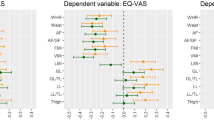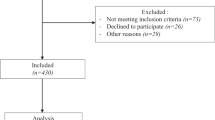Abstract
OBJECTIVE: To describe perceived disability in obese women.
DESIGN: Comparisons of perceived disability in obese women and in a normal-weight reference group regarding activities of daily life (ADL), mobility, housework and professional work as well as comparisons of perceived disability and observed functional limitations reported in a previous study.
SUBJECTS: Fifty-seven consecutively selected obese female outpatients, mean age 44 y (body mass index (BMI) 37 kg/m2) and 22 voluntary referents, mean age 49 y (BMI 22 kg/m2).
MAIN OUTCOME MEASURES: A pain questionnaire (for background data) and a disability questionnaire, which is new, detailed and specific with test–retest stability and content- and criterion-referenced validity. Comparisons of results from the questionnaire and a functional test regarding observations of similar functional limitations.
RESULTS: The obese women perceived disability to a much higher extent (P<0.003) than did the normal-weight women. The main problems concerned occupational work in strenuous positions, strain and pain, sports, walking outdoors or on stairs, and moderate housework requiring squatting, stooping or lifting. Rising from sofas, pedicure and stress incontinence were problematic. The correlation between perceived disability and functional limitations was fairly good (rs=0.56) but ranged widely (rs=0.14–0.61). Within the group of obese women the disability neither correlated to BMI nor age, rather to lower-body pain.
CONCLUSION: The disability questionnaire conveyed new and detailed information of disability problems in everyday life in obese women. It highlighted the difference between the disability these women may perceive and the functional limitations we can observe and measure. This result is of great clinical relevance in the care of obese women.
This is a preview of subscription content, access via your institution
Access options
Subscribe to this journal
Receive 12 print issues and online access
$259.00 per year
only $21.58 per issue
Buy this article
- Purchase on Springer Link
- Instant access to full article PDF
Prices may be subject to local taxes which are calculated during checkout

Similar content being viewed by others
References
World Health Organization . Obesity Preventing and managing the global epidemic. World Health Organization: Geneva 1998
Deurenberg P, Hautvast JG . Prevalence of overweight and obesity in the Netherlands in relation to sociodemographic variables, lifestyle and eating behavior: starting points for the prevention and treatment of obesity Bibl Nutr Dieta 1989 44: 8–21.
Kuskowska-Wolk A, Rössner S . Body mass distribution of a representative adult population in Sweden Diabetes Res Clin Pract 1990 10: 37–41.
Rippe M . The case for medical management of obesity: a call for increased physician involvement Obes Res 1998 6: (Suppl 1): 23–33.
Rissanen A, Heliövaara M, Knekt P, Reunan A, Aromaa A, Maatela J . Risk of disability and mortality due to overweight in a Finnish population Br Med J 1990 301: 835–837.
Buchowski MS, Sun M . Energy expenditure, television viewing and obesity Int J Obes Relat Metab Disord 1996 20: 236–244.
Stafford M, Hemingway H, Mannot M . Current obesity, steady weight change and weight fluctuation as predictors of physical functioning in middle aged office workers: the Whitehall II study Int J Obes Relat Metab Disord 1998 22: 23–31.
Martinez-Gonzalez IA, Alfredo Martinez J, Hu FB, Gibney MJ, Kearney J . Physical inactivity, sedentary lifestyle and obesity in the European Union Int J Obes Relat Metab Disord 1999 23: 1192–1201.
van Itallie TB, Lew EA . Health implications of overweight in the elderly Prog Clin Biol Res 1990 326: 89–108.
Felson DT, Anderson JJ, Naimark A, Walker AM, Meenan RF . Obesity and knee osteoarthritis. The Framingham study. Ann Intern Med 1988 109: 18–24.
Kuskowska-Wolk A, Rössner S . Decreased social activity in obese adults Diabetes Res Clin Pract 1990 10: (Suppl 1): 265–269.
de Groot LC, van Staveren WA . Reduced physical activity and its association with obesity Nutr Rev 1995 53: 11–13.
Han TS, Tijhuis MA, Lean ME, Seidell JC . Quality of life in relation to overweight and body fat distribution Am J Public Health 1998 88: 1814–1820.
Choban PS, Onyejekwe J, Burge JC, Flancbaum L . A health status assessment of impact of weight loss following Rox-en-Y gastric bypass for clinically severe obesity J Am Coll Surg 1999 188: 491–497.
Fontaine KR, Barofsky I, Andersen RE, Bartlett SJ, Wiersema L, Cheskin LJ, Franckowiak SC . Impact of weight loss on health-related quality of life Qual Life Res 1999 8: 275–277.
Mattsson E, Evers Larsson U, Rössner S . Is walking too exhausting for obese women? Int J Obes Relat Metab Disord 1997 21: 380–386.
Mandroukas K, Krotiewsky M, Hedberg M, Björntorp P, Grimby G, Wroblewsky Z . Physical training in obese women Eur J Appl Physiol 1984 52: 355–361.
Rowland T . Effects of obesity on aerobic fitness in adolescent females Sports Med 1991 145: 764–768.
Narbro K, Jonsson E, Larsson B, Waaler H, Wedel H, Sjostrom L . Economic consequences of sick-leave and early retirement in obese Swedish women Int J Obes Relat Metab Disord 1996 20: 895–903.
Blair SN . Evidence for success of exercise in weight control Ann Intern Med 1993 119: 702–706.
Blair SN, Kampert JB, Kohl HW, Barlow CE, Macera CA, Paffenbarger RS et al. Influences of cardiorespiratory fitness and other precursors on cardiovascular disease and all-cause mortality in men and women JAMA 1996 276: 205–210.
Tryon WW, Goldberg JL, Morrison DF . Activity decreases as percentage overweight increases Int J Obes Relat Metab Disord 1992 16: 591–595.
Maddox GL, Back KW, Liberman VL . Overweight as social deviance and disability J Health Soc Behav 1968 9: 287–298.
Ferraro KF, Booth TL . Age, body mass index, and functional illness J Gerontol B Psychol Sci Soc Sci 1999 6: 339–348.
Lean ME, Han TS, Seidell JC . Impairment of health and quality of life using new US federal guidelines for the identification of obesity Arch Intern Med 1999 159: 837–843.
Fontaine KR, Cheskin LJ, Barofsky I . Health-related quality of life in obese persons seeking treatment J Fam Pract 1996 43: 265–270.
Evers Larsson U, Mattsson E . Functional limitations linked to high body mass index, age and current pain in obese women Int J Obes Relat Metab Disord 2001 25: 893–899.
Sullivan M . Sickness impact profile: introduktion av en svensk version för mätning av sjukdomskonsekvenser Läkartidningen 1985 82: 1861–1862. (In Swedish.).
Wiklund I, Dimenäs E . Svensk version av Nottingham Health Profile. Frågeformulär mäter hälsorelaterad livskvalitet Läkartidningen 1990 87: 1575–1576. (In Swedish.).
Sullivan M, Karlsson J, Ware JE . The Swedish SF-36 Health Survey I. Evaluation of data quality, scaling assumptions, reliability, and construct validity across general populations in Sweden. Soc Sci Med 1995 41: 1349–1358.
Verbrugge LM, Jette AM . The disablement process Soc Sci Med 1994 38: 1–14.
Örebroformulär 007D. FSF-METOD AB Örebro, Sweden
McDowell I, Newell C . Measuring health A guide to rating scales and questionnaires. University of Ottawa/Oxford University Press: Oxford 1987
Salén BA, Spangfort EV, Nygren ÅL, Nordemar R . The disability rating index: An instrument for the assessment of disability in clinical settings J Clin Epidemiol 1994 12: 1423–1434.
Svensson E . Ordinal invariant measures for individual and group changes in ordered categorical data Stat Med 1998 17: 2923–2936.
Bland JM, Altman DG . Statistical methods for assessing agreement between two methods of clinical measurement Lancet 1986 8: 307–310.
Fall M, Frankenberg S, Frisén M, Larsson B, Petrén M . 456 000 Swedes may have urinary incontinence. Only every fourth person seeks help for the disorder. Läkartidningen 1985 82: 2054–2056. (in Swedish.).
Myers A, Rosen JC . Obesity stigmatization and coping: relation to mental health symptoms, body image, and self-esteem Int J Obes Relat Metab Disord 1999 23: 221–230.
Wadden TA, Stunkard AJ . Social and psychological consequences of obesity Ann Intern Med 1985 103: 1062–1067.
Maiman LA, Wang VL, Becker MH, Finlay J, Simonsson M . Attitudes toward obesity and the obese among professionals J Am Diet Assoc 1979 74: 331–336.
Svensson E, Holm S . Separation of systematic and random differences in ordinal rating scales Stat Med 1994 13: 2437–2453.
Stensman R . Severely mobility-disabled people assess the quality of their lives Scand J Rehabil Med 1985 17: 87–99.
Acknowledgements
This study was supported by the Department of Physical Therapy and the Committee for the Health and Caring Sciences at the Karolinska Institutet, and carried out at the Departments of Physical Therapy and Medicine at the Karolinska Institutet. We thank Professor Stephan Rössner and his staff for generously providing patients and all the women who took time to participate in this study. Physiotherapists Marit Lindfors and Ulla Rickfors helped us to perform the validity tests in an excellent way. Jan Kowalski, statistician, and Tim Crosfield, lingustic reviewer, have been of great help.
Author information
Authors and Affiliations
Corresponding author
Rights and permissions
About this article
Cite this article
Evers Larsson, U., Mattsson, E. Perceived disability and observed functional limitations in obese women. Int J Obes 25, 1705–1712 (2001). https://doi.org/10.1038/sj.ijo.0801805
Received:
Revised:
Accepted:
Published:
Issue Date:
DOI: https://doi.org/10.1038/sj.ijo.0801805
Keywords
This article is cited by
-
Fear of falling in obese women under 50 years of age: a cross-sectional study with exploration of the relationship with physical activity
BMC Obesity (2019)
-
Psychological Impact of Severe Obesity
Current Obesity Reports (2016)
-
Risk factors of acute and overuse musculoskeletal injuries among young conscripts: a population-based cohort study
BMC Musculoskeletal Disorders (2015)
-
Gender variations of body composition, muscle strength and power output in morbid obesity
International Journal of Obesity (2005)
-
Influence of weight loss on pain, perceived disability and observed functional limitations in obese women
International Journal of Obesity (2004)



